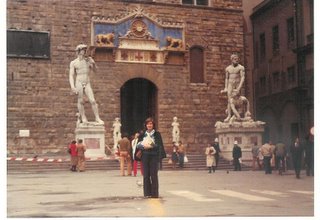LET'S START WITH FLORENCE!

"LOGGIA DEI LANZI - built between 1376 and 1382 to house the assemblies of the people and hold public ceremonies, it houses today a series of classical and Mannerist sculptures. These include the beautiful «Rape of the Sabines» (1583), «Hercules fighting the centaur Nessus» (1599), both of them by Giambologna, and the «Perseus with the head of the Medusa» by Cellini (1545-54)"

"PIAZZA DELLA SIGNORIA - the political heart of the city from the Middle Ages to the present day, gets its name from the Palazzo della Signoria, designed by Arnolfo di Cambio in 1298-99 for the seat of the Republican government. When the Grand Duke and his family moved to the new palace of Pitti in 1565, Palazzo della Signoria began to be known as Palazzo Vecchio. The copy of Michelangelo's «David» is on the left of the door"

"UFFIZZI - The Uffizi Palace was constructed in the mid-sixteenth century by Vasari (1511-1574). Built in the form of a horse shoe extending from Piazza Signoria to the River Arno and linked with Palazzo Vecchio by a bridge over the street, the Uffizi were intended to house the offices of the magistrature. From the beginning however, the Medici set aside certain rooms on the third floor to house the finest works from their collections; two centuries later, in 1737, thanks to the far-seeing generosity of the last heir of the family, Anna Maria Luisa, their collection became permanent public property. One of the most fabulous museums in the world!"

"PONTE VECCHIO - Built in ancient times by the Etruscans, the bridge has weathered many storms - and storming by invading legions. Because of its location over the widest part of the Arno River, the bridge has been rebuilt and restored many times throughout its long history"

"PONTE VECCHIO - The Ponte Vecchio is the only of Florence's bridges to have survived WWII, and in 1966, when a massive flood wiped out the shops on the bridge, the bridge itself was strong enough to withstand the roaring waters"

"PADUA - people there calls Santo António «the patron and defender of the city». St. Anthony was renowned for performing various miracles, died in 1231, and to his memory the people erected the Basilica di San Antonio (photo). The church itself is one of the major tourist attractions in Padua, designed with a blend of Romanesque and Byzantine styles and housing a beautiful high altar crafted by Donatello. Anyone with a bit of culture, however, knows that Santo António is not «of Padua», but of Lisbon, Portugal, where he was born in 1195"
No comments:
Post a Comment